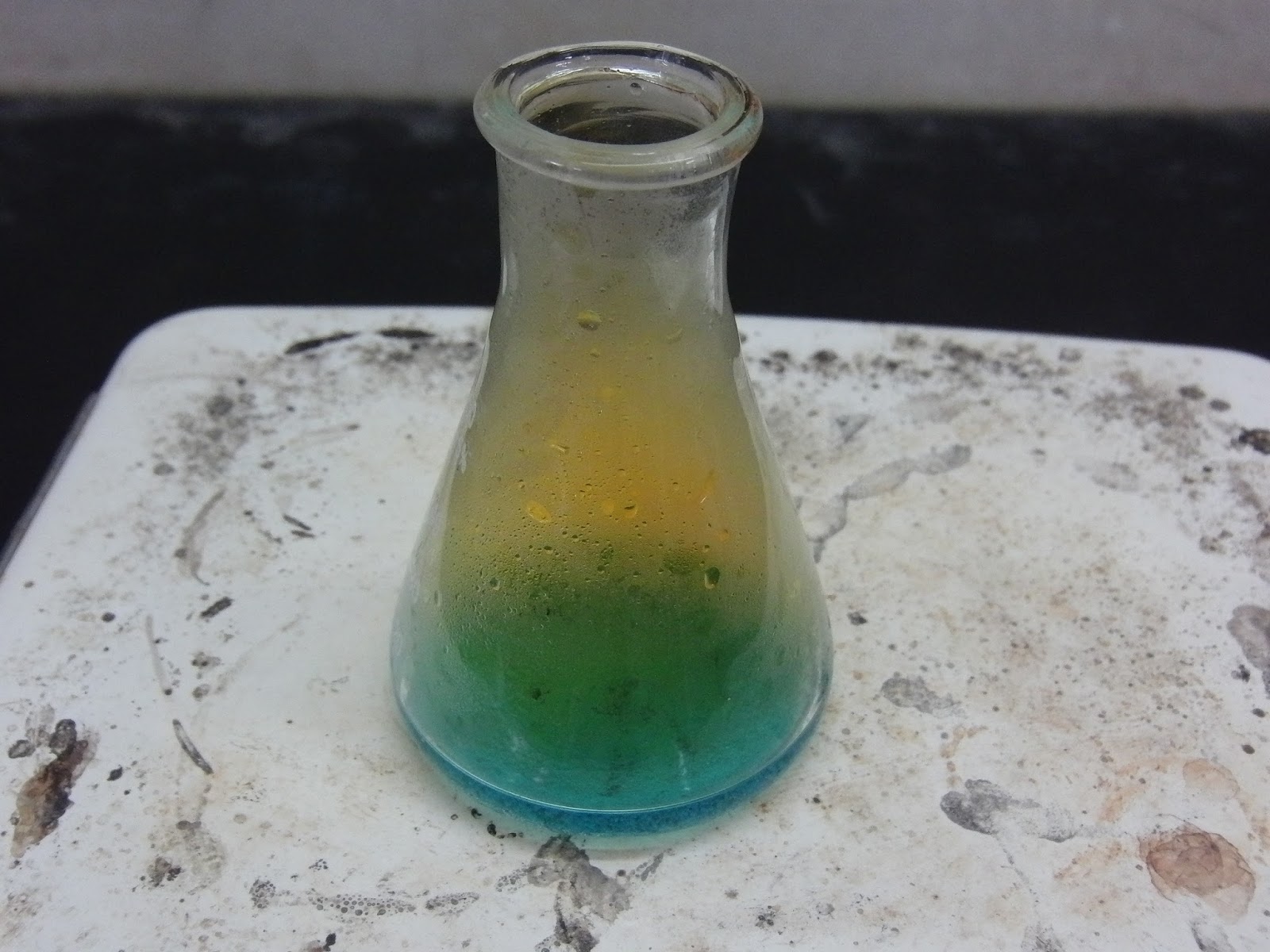Discussion
Thiosulfate can
also be standardized against pure copper wire or foil. This procedure is
advantageous when the solution is to be used for the determination of copper because
any systematic error in the method tends to be canceled.
Copper(II) is reduced quantitatively to
copper(I) by iodate ion:
2Cu2+ + 4I-
→ 2CuI(s) + I2
The importance
of CuI formation in the forcing this reaction to completion can be seen from
the following standard electrode potentials:
Cu2+ + e- ↹ Cu+ E0 = 0.15 V
I2
+ 2e- ↹ 2I-
E0 = 0.54 V
Cu2+
+ I- + e- ↹ CuI(s) E0 = 0.86 V
The first two
potentials suggest that iodide should have no tendency to reduce copper(II);
the formation of CuI, however, favors the reduction. The solution must contain
at least 4% excess iodide to force the reaction to completion. Moreover, the pH
must be less than 4 to prevent the formation of basic copper species that react
slowly and incompletely with iodide ion. The acidity of the solution cannot be
greater than about 0.3M, however, because of the tendency of iodide ion to
undergo air oxidation, a process catalyzes by copper salts. Nitrogen oxides
also catalyze the air oxidation of iodide ion. A common source of these oxides
is the nitric acid ordinarily used to dissolve metallic copper and other
copper-containing solids. Urea is used to scavenge nitrogen oxides from
solutions:
(NH2)2CO
+ 2HNO2 → 2N2
(g) + CO2 (g) + 3H2O
The titration of
iodine by thiosulfate tends to yield slightly low results owing to the
adsorption of small but measurable quantities of iodine on solid CuI. The
adsorbed iodine is released only slowly, even when thiosulfate is in excess;
transient and premature end points result. This difficulty is largely overcome
by the addition of thiocyanate ion. The sparingly soluble copper(I) thiocyanate
replaces part of the copper iodide at the surface of the solid:
CuI(s)
+ SCN- → CuSCN(s)
+I-
Accompanying this
reaction is the release of the adsorbed iodine, which thus becomes available
for titrated to prevent interference from a slow reaction between the two
species, possibly
2SCN- +
I2 → (SCN)2
The
standardization procedure is readily adapted to the determination of copper in
the copper alloy that also contains appreciable amounts of tin, lead, and zinc
(and perhaps minor amounts of nickel and iron). The method is relatively simple
and applicable to brasses with less than 2% iron. A weighted sample is treated
with nitric acid, which causes the tin to precipitate as a hydrates oxide of
uncertain composition. Evaporation with sulfuric acid to the appearance of
sulfur trioxide eliminates the excess nitrate, redissolves the tin compound,
and possibly causes the formation of lead sulfate. The pH is adjusted through
the addition of ammonia, followed by acidification with a measure amount of
phosphoric acid. An excess of potassium iodide is added, and the liberated
iodine is titrated with standard thiosulfate.
Procedure
1. Weight
(to the nearest 0.1mg) 0.3g samples into 250 mL conical flasks, and introduce 5
mL of 6 M HNO3 into each; warm (use the hood) until solution is
complete.
Powder of Copper Sample (Pure Copper)
Nitrogen dioxide is evaporating
2. Add
10 mL of concentrated H2SO4, and evaporate (use the hood)
until copious white fumes of SO3 are given off. Allow the mixture to
coll.
3. Cautiously
add 30 mL of distilled water, boil for 1 to 2 min, and again cool.
4. Add
concentrated NH3 dropwise and with thorough mixing to produce the
intensely blue Cu(NH3)42+ ; the solution
should smell faintly of ammonia[1].
Some Cu(OH)2 forms at the initial of adding aqueous ammonia
5. Make
dropwise additions of 3 M H2SO4 until the color of the
complex just disappears, and then add 2.0 mL of 85% H3PO4
[2]. Cool to room temperature.
6. Treat
each sample individually from this point on to minimize the air oxidation of
iodine ion. Add 4.0 g of KI to the sample, and titrate immediately with Na2S2O3
until the solution becomes pale yellow.
7. Add 5
mL of starch indicator, and continue the titration until the blue color becomes
fanit.
8. Add 2
g of KSCN; swirl vigorously for 30 s.
9. Complete
the titration, using the disappearance of the blue starch/I2 color
as the end point.
10. Report
the percentage of Cu in the sample.
Notes
[1] Do not sniff
vapors directly from the flask; instead, waft them toward your nose with a
waving motion of your hand.
[2] The H3PO4
can form precipitate with some impurities such as iron and nickel.
Experimental
Record
|
Weight of
Copper Sample
|
0.300 g
|
|
|
= 4.721 mmol
|
|
Molarity of Na2S2O3
|
0.100 M
|
|
Consumption of
Na2S2O3
|
10.80 mL
|
|
|
11.40 mL
|
|
Average
|
11.10
mL
|
|
Weight of
Copper
|
11.10x0.100x(42.5/10.0)
|
|
|
= 4.718 mmol
|
|
Percentage of
Copper in the sample
|
(4.718
/ 4.721) x 100%
|
|
|
= 99.94 %
|










Where you using a specific kind of copper??
ReplyDeletewould the number change significantly if I used A81